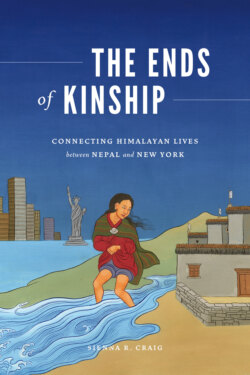Читать книгу The Ends of Kinship - Sienna R. Craig - Страница 11
На сайте Литреса книга снята с продажи.
PART I ATTENDING TO BIRTH
ОглавлениеEach thing
I did, then, I did for the first
time, touched the flesh of our flesh,
brought the tiny mouth to my breast,
she drew the avalanche of milk
down off the mountain, I felt as if
I was nothing, no one, I was everything to her, I was hers.
—SHARON OLDS, “FIRST BIRTH”
Pregnancy and early childhood are filled with precarity and joy no matter where they occur. Like women across the Himalaya and Tibetan Plateau, those from Mustang have faced many challenges in bringing new life into this world. Geography can create obstacles to care. Roads can be inaccessible and unreliable, as can hospitals and health posts. To practice medicine of any sort in rural Nepal remains a challenge. To proceed with knowledge and skill, under material conditions that meet the needs of women and children during pregnancy, labor, and delivery, sometimes proves impossible. The khora of migration is shifting Mustang women’s experiences of pregnancy and childbirth. Migrations have allowed access to city hospitals and Cesarean sections, birth certificates, and contraception. These transformations, in turn, have shifted aspects of what it means to be a woman and a mother in Mustang itself.
The short story, “Blood and Bone,” introduces three generations of Mustang women: a grandmother, her daughter, and her daughter’s daughter. In culturally Tibetan circles, blood, trak, comes from the mother, whereas the father passes on his bone, rü. This is a way of speaking about kinship and belonging, one’s biological and cultural inheritance. This story moves across time and space—from Monthang to Kathmandu to Queens. In so doing, it explores what is remembered and forgotten, shared and silenced, of women’s experiences over the last half-century.
The ethnographic chapter, “Finding the Womb Door,” describes how women’s reproductive histories have changed over the past few generations. Its title refers to the ways that people from Mustang speak about reincarnation and what it means to be human. In other cultural contexts, birth might be framed as the nascence of life. In Mustang, it is viewed as a circling, another form of khora. After death comes rebirth. After the bardo, the in-between realm between one life and the next, a consciousness passes through an available womb door. Then, if karmic and biological circumstances align, it rests here, forming into new life.
But this Buddhist way of knowing says little about the lived experiences of pregnancy, birth, and young childhood. To this end, the chapter also examines how forms of harm, at once spiritual and structural, can shape these processes and considers how the khora of migration reconfigures family relationships. Social reproduction begins with a biological imperative—a primal intimacy that shapes humanity. It matters where and how this occurs. What falls out from these couplings? How is new life caught and held?
